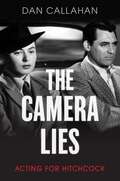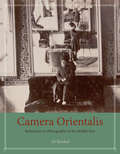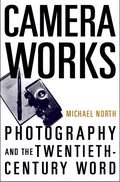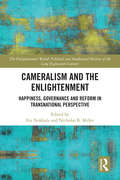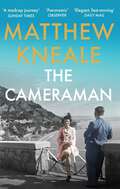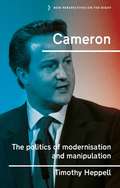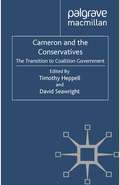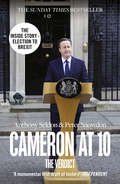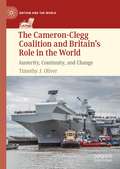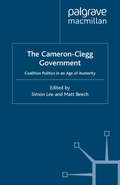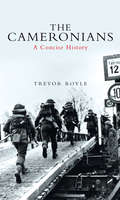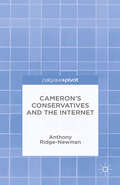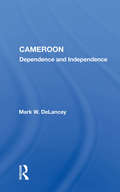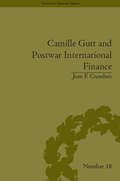- Table View
- List View
The Camera Lies: Acting for Hitchcock
by Dan CallahanThe first book on Hitchcock that focuses exclusively on his work with actors Alfred Hitchcock is said to have once remarked, "Actors are cattle," a line that has stuck in the public consciousness ever since. For Hitchcock, acting was a matter of contrast and counterpoint, valuing subtlety and understatement over flashiness. He felt that the camera was duplicitous, and directed actors to look and act conversely. In The Camera Lies, author Dan Callahan spotlights the many nuances of Hitchcock's direction throughout his career, from Cary Grant in Notorious (1946) to Janet Leigh in Psycho (1960). Delving further, he examines the ways that sex and sexuality are presented through Hitchcock's characters, reflecting the director's own complex relationship with sexuality. Detailing the fluidity of acting -- both what it means to act on film and how the process varies in each actor's career -- Callahan examines the spectrum of treatment and direction Hitchcock provided well- and lesser-known actors alike, including Ingrid Bergman, Henry Kendall, Joan Barry, Robert Walker, Jessica Tandy, Kim Novak, and Tippi Hedren. As Hitchcock believed, the best actor was one who could "do nothing well" - but behind an outward indifference to his players was a sophisticated acting theorist who often drew out great performances. The Camera Lies unpacks Hitchcock's legacy both as a director who continuously taught audiences to distrust appearance, and as a man with an uncanny insight into the human capacity for deceit and misinterpretation.
The Camera Lies: Acting for Hitchcock
by Dan CallahanThe first book on Hitchcock that focuses exclusively on his work with actors Alfred Hitchcock is said to have once remarked, "Actors are cattle," a line that has stuck in the public consciousness ever since. For Hitchcock, acting was a matter of contrast and counterpoint, valuing subtlety and understatement over flashiness. He felt that the camera was duplicitous, and directed actors to look and act conversely. In The Camera Lies, author Dan Callahan spotlights the many nuances of Hitchcock's direction throughout his career, from Cary Grant in Notorious (1946) to Janet Leigh in Psycho (1960). Delving further, he examines the ways that sex and sexuality are presented through Hitchcock's characters, reflecting the director's own complex relationship with sexuality. Detailing the fluidity of acting -- both what it means to act on film and how the process varies in each actor's career -- Callahan examines the spectrum of treatment and direction Hitchcock provided well- and lesser-known actors alike, including Ingrid Bergman, Henry Kendall, Joan Barry, Robert Walker, Jessica Tandy, Kim Novak, and Tippi Hedren. As Hitchcock believed, the best actor was one who could "do nothing well" - but behind an outward indifference to his players was a sophisticated acting theorist who often drew out great performances. The Camera Lies unpacks Hitchcock's legacy both as a director who continuously taught audiences to distrust appearance, and as a man with an uncanny insight into the human capacity for deceit and misinterpretation.
Camera Orientalis: Reflections on Photography of the Middle East
by Ali BehdadIn the decades after its invention in 1839, photography was inextricably linked to the Middle East. Introduced as a crucial tool for Egyptologists and Orientalists who needed to document their archaeological findings, the photograph was easier and faster to produce in intense Middle Eastern light—making the region one of the original sites for the practice of photography. A pioneering study of this intertwined history, Camera Orientalis traces the Middle East’s influences on photography’s evolution, as well as photography’s effect on Europe’s view of “the Orient.” Considering a range of Western and Middle Eastern archival material from the late nineteenth and early twentieth centuries, Ali Behdad offers a rich account of how photography transformed Europe’s distinctly Orientalist vision into what seemed objective fact, a transformation that proved central to the project of European colonialism. At the same time, Orientalism was useful for photographers from both regions, as it gave them a set of conventions by which to frame exotic Middle Eastern cultures for Western audiences. Behdad also shows how Middle Eastern audiences embraced photography as a way to foreground status and patriarchal values while also exoticizing other social classes. An important examination of previously overlooked European and Middle Eastern photographers and studios, Camera Orientalis demonstrates that, far from being a one-sided European development, Orientalist photography was the product of rich cultural contact between the East and the West.
Camera Orientalis: Reflections on Photography of the Middle East
by Ali BehdadIn the decades after its invention in 1839, photography was inextricably linked to the Middle East. Introduced as a crucial tool for Egyptologists and Orientalists who needed to document their archaeological findings, the photograph was easier and faster to produce in intense Middle Eastern light—making the region one of the original sites for the practice of photography. A pioneering study of this intertwined history, Camera Orientalis traces the Middle East’s influences on photography’s evolution, as well as photography’s effect on Europe’s view of “the Orient.” Considering a range of Western and Middle Eastern archival material from the late nineteenth and early twentieth centuries, Ali Behdad offers a rich account of how photography transformed Europe’s distinctly Orientalist vision into what seemed objective fact, a transformation that proved central to the project of European colonialism. At the same time, Orientalism was useful for photographers from both regions, as it gave them a set of conventions by which to frame exotic Middle Eastern cultures for Western audiences. Behdad also shows how Middle Eastern audiences embraced photography as a way to foreground status and patriarchal values while also exoticizing other social classes. An important examination of previously overlooked European and Middle Eastern photographers and studios, Camera Orientalis demonstrates that, far from being a one-sided European development, Orientalist photography was the product of rich cultural contact between the East and the West.
Camera Orientalis: Reflections on Photography of the Middle East
by Ali BehdadIn the decades after its invention in 1839, photography was inextricably linked to the Middle East. Introduced as a crucial tool for Egyptologists and Orientalists who needed to document their archaeological findings, the photograph was easier and faster to produce in intense Middle Eastern light—making the region one of the original sites for the practice of photography. A pioneering study of this intertwined history, Camera Orientalis traces the Middle East’s influences on photography’s evolution, as well as photography’s effect on Europe’s view of “the Orient.” Considering a range of Western and Middle Eastern archival material from the late nineteenth and early twentieth centuries, Ali Behdad offers a rich account of how photography transformed Europe’s distinctly Orientalist vision into what seemed objective fact, a transformation that proved central to the project of European colonialism. At the same time, Orientalism was useful for photographers from both regions, as it gave them a set of conventions by which to frame exotic Middle Eastern cultures for Western audiences. Behdad also shows how Middle Eastern audiences embraced photography as a way to foreground status and patriarchal values while also exoticizing other social classes. An important examination of previously overlooked European and Middle Eastern photographers and studios, Camera Orientalis demonstrates that, far from being a one-sided European development, Orientalist photography was the product of rich cultural contact between the East and the West.
Camera Orientalis: Reflections on Photography of the Middle East
by Ali BehdadIn the decades after its invention in 1839, photography was inextricably linked to the Middle East. Introduced as a crucial tool for Egyptologists and Orientalists who needed to document their archaeological findings, the photograph was easier and faster to produce in intense Middle Eastern light—making the region one of the original sites for the practice of photography. A pioneering study of this intertwined history, Camera Orientalis traces the Middle East’s influences on photography’s evolution, as well as photography’s effect on Europe’s view of “the Orient.” Considering a range of Western and Middle Eastern archival material from the late nineteenth and early twentieth centuries, Ali Behdad offers a rich account of how photography transformed Europe’s distinctly Orientalist vision into what seemed objective fact, a transformation that proved central to the project of European colonialism. At the same time, Orientalism was useful for photographers from both regions, as it gave them a set of conventions by which to frame exotic Middle Eastern cultures for Western audiences. Behdad also shows how Middle Eastern audiences embraced photography as a way to foreground status and patriarchal values while also exoticizing other social classes. An important examination of previously overlooked European and Middle Eastern photographers and studios, Camera Orientalis demonstrates that, far from being a one-sided European development, Orientalist photography was the product of rich cultural contact between the East and the West.
Camera Orientalis: Reflections on Photography of the Middle East
by Ali BehdadIn the decades after its invention in 1839, photography was inextricably linked to the Middle East. Introduced as a crucial tool for Egyptologists and Orientalists who needed to document their archaeological findings, the photograph was easier and faster to produce in intense Middle Eastern light—making the region one of the original sites for the practice of photography. A pioneering study of this intertwined history, Camera Orientalis traces the Middle East’s influences on photography’s evolution, as well as photography’s effect on Europe’s view of “the Orient.” Considering a range of Western and Middle Eastern archival material from the late nineteenth and early twentieth centuries, Ali Behdad offers a rich account of how photography transformed Europe’s distinctly Orientalist vision into what seemed objective fact, a transformation that proved central to the project of European colonialism. At the same time, Orientalism was useful for photographers from both regions, as it gave them a set of conventions by which to frame exotic Middle Eastern cultures for Western audiences. Behdad also shows how Middle Eastern audiences embraced photography as a way to foreground status and patriarchal values while also exoticizing other social classes. An important examination of previously overlooked European and Middle Eastern photographers and studios, Camera Orientalis demonstrates that, far from being a one-sided European development, Orientalist photography was the product of rich cultural contact between the East and the West.
Camera Orientalis: Reflections on Photography of the Middle East
by Ali BehdadIn the decades after its invention in 1839, photography was inextricably linked to the Middle East. Introduced as a crucial tool for Egyptologists and Orientalists who needed to document their archaeological findings, the photograph was easier and faster to produce in intense Middle Eastern light—making the region one of the original sites for the practice of photography. A pioneering study of this intertwined history, Camera Orientalis traces the Middle East’s influences on photography’s evolution, as well as photography’s effect on Europe’s view of “the Orient.” Considering a range of Western and Middle Eastern archival material from the late nineteenth and early twentieth centuries, Ali Behdad offers a rich account of how photography transformed Europe’s distinctly Orientalist vision into what seemed objective fact, a transformation that proved central to the project of European colonialism. At the same time, Orientalism was useful for photographers from both regions, as it gave them a set of conventions by which to frame exotic Middle Eastern cultures for Western audiences. Behdad also shows how Middle Eastern audiences embraced photography as a way to foreground status and patriarchal values while also exoticizing other social classes. An important examination of previously overlooked European and Middle Eastern photographers and studios, Camera Orientalis demonstrates that, far from being a one-sided European development, Orientalist photography was the product of rich cultural contact between the East and the West.
Camera Works: Photography and the Twentieth-Century Word
by Michael NorthCamera Works is about the impact of photography and film on modern art and literature. For many artists and writers, these new media offered hope of new means of representation, neither linguistic nor pictorial, but hovering in a kind of utopian space between. At the same time, the new media introduced a dramatic element of novelty into the age-old evidence of the senses. For the avant-garde, the challenges of the new media were the modern in its most concentrated form, but even for aesthetically unadventurous writers they constituted an element of modern experience that could hardly be ignored. Camera Works thus traces some of the more utopian projects of transatlantic avant-garde, including the Readie machine of Bob Brown, which was to turn stories and poems into strips of linguistic film. The influence of photography and film on the avant-garde is traced from the early days of Camera Work, through the enthusiasm of Eugene Jolas and the contributors to his magazine transition, to the crisis created by the introduction of sound in the late 1920's. Subseguent chapters describe the entirely new kind of sensory enjoyment brought into modern American fiction by the new media. What Fitzgerald calls "spectroscopic gayety," the enjoyable diorientation of the senses by machine perception, turns out to be a powerful force in much American fiction. The revolutionary possibilities of this new spectatorship and its limitations are pursued through a number of examples, including Dos Passos, James Weldon Johnson, and Hemingway. Together, these chapters offer a new and substantially different account of the relationship between modern American literature and the mediatized society of the early twentieth century. With a comprehensive introduction and detailed particular readings, Camera Works substantiates a new understanding of the formal and historical bases of modernism. It argues that when modern literature and art respond to modernity, on a formal level, they are responding to the intervention of technology in the transmission of meaning, an intervention that unsettles all the terms in the essential relationship of human consciousness to the world of phenomena.
Cameralism and the Enlightenment: Happiness, Governance and Reform in Transnational Perspective (The Enlightenment World)
by Ere Nokkala Nicholas B. MillerCameralism and the Enlightenment reassesses the relationship between two key phenomena of European history often disconnected from each other. It builds on recent insights from global history, transnational history and Enlightenment studies to reflect on the dynamic interactions of cameralism, an early modern set of practices and discourses of statecraft prominent in central Europe, with the broader political, intellectual and cultural developments of the Enlightenment world. Through contributions from prominent scholars across the field of Enlightenment studies, the volume analyzes eighteenth-century cameralist authors’ engagements with commerce, colonialism and natural law. Challenging the caricature of cameralism as a German, land-locked version of mercantilism, the volume reframes its importance for scholars of the Enlightenment broadly conceived. This volume goes beyond the typical focus on Britain and France in studies of political economy, widening perspectives about the dissemination of ideas of governance, happiness and reform to focus on multidirectional exchanges across continental Europe and beyond during the eighteenth century. Emphasizing the practice of theory, it proposes the study of the porosity of ideas in their exchange, transmission and mediation between spaces and discourses as a key dimension of cultural and intellectual history.
Cameralism and the Enlightenment: Happiness, Governance and Reform in Transnational Perspective (The Enlightenment World)
by Ere Nokkala Nicholas B. Miller Anthony J. La VopaCameralism and the Enlightenment reassesses the relationship between two key phenomena of European history often disconnected from each other. It builds on recent insights from global history, transnational history and Enlightenment studies to reflect on the dynamic interactions of cameralism, an early modern set of practices and discourses of statecraft prominent in central Europe, with the broader political, intellectual and cultural developments of the Enlightenment world. Through contributions from prominent scholars across the field of Enlightenment studies, the volume analyzes eighteenth-century cameralist authors’ engagements with commerce, colonialism and natural law. Challenging the caricature of cameralism as a German, land-locked version of mercantilism, the volume reframes its importance for scholars of the Enlightenment broadly conceived. This volume goes beyond the typical focus on Britain and France in studies of political economy, widening perspectives about the dissemination of ideas of governance, happiness and reform to focus on multidirectional exchanges across continental Europe and beyond during the eighteenth century. Emphasizing the practice of theory, it proposes the study of the porosity of ideas in their exchange, transmission and mediation between spaces and discourses as a key dimension of cultural and intellectual history.
The Cameraman
by Matthew KnealeFormer cinema camera director Julius Sewell journeys across Europe with his family to his sister's wedding in Rome. But this will be an unusual road trip. For one thing, Julius has been in an institution and has only just been released to travel. And then there is his family. This is Easter 1934 and Julius' stepfather and mother are keen members of Oswald Mosley's new party, the British Union of Fascists. One of Julius' half-sisters is in studying in Munich, where she dreams of meeting meet her idol, Adolf Hitler. Another half-sister is a member of the British Communist Party, and is determined to wreck the approaching wedding, because the groom is a rising figure in Italy's Fascist regime. As the family motors south, to Paris, across Nazi Germany - taking in a bus tour to Dachau concentration camp - and through Mussolini's Italy to Rome, gathering relatives and a stray dog along the way, Julius' mental stability will be put sorely to the test, as will be the sanity of his relatives.
Cameron: The politics of modernisation and manipulation (New Perspectives on the Right #3)
by Timothy HeppellDavid Cameron was leader of the Conservative Party (2005-16) and Prime Minister of the United Kingdom (2010-16). His legacy may be one of the most significant of any post-war British prime minister. But did he have a distinctive political strategy, and if so how should we characterise it? This book provides a new and distinctive interpretation of ‘Cameronism’, focusing on the twin themes of modernisation and manipulation.Heppell identifies three core aspects of Cameron’s modernisation strategy: his attempts to detoxify the image of the Conservative Party; his efforts to delegitimise the Labour Party by blaming it for the financial crisis and austerity; and Cameron’s use of the ‘Big Society’ narrative as a means of reducing the perceived responsibilities of the state. Manipulation is explored in relation to the Coalition Government and the exploitation of the Liberal Democrats, on policies such as austerity, tuition fees and electoral reform. Finally, the book examines Cameronism in relation to current challenges to the existing political order: Brexit, Scottish independence, and the rise of populism. This timely book is essential reading to those interested in British party politics and Prime Ministerial leadership.
Cameron: The politics of modernisation and manipulation (New Perspectives on the Right #3)
by Timothy HeppellDavid Cameron was leader of the Conservative Party (2005-16) and Prime Minister of the United Kingdom (2010-16). His legacy may be one of the most significant of any post-war British prime minister. But did he have a distinctive political strategy, and if so how should we characterise it? This book provides a new and distinctive interpretation of ‘Cameronism’, focusing on the twin themes of modernisation and manipulation.Heppell identifies three core aspects of Cameron’s modernisation strategy: his attempts to detoxify the image of the Conservative Party; his efforts to delegitimise the Labour Party by blaming it for the financial crisis and austerity; and Cameron’s use of the ‘Big Society’ narrative as a means of reducing the perceived responsibilities of the state. Manipulation is explored in relation to the Coalition Government and the exploitation of the Liberal Democrats, on policies such as austerity, tuition fees and electoral reform. Finally, the book examines Cameronism in relation to current challenges to the existing political order: Brexit, Scottish independence, and the rise of populism. This timely book is essential reading to those interested in British party politics and Prime Ministerial leadership.
Cameron and the Conservatives: The Transition to Coalition Government
by Timothy Heppell and David SeawrightSpecialists in Conservative Party politics examine the effectiveness of the Cameron led coalition. The contributors examine Cameron as leader and Prime Minister; the Conservatives' modernisation strategy; the level of ideological coherence in 'liberal conservatism'; and the impact of the coalition on a range of policy areas and on 'New' Labour.
Cameron at 10: From Election to Brexit
by Anthony Seldon Peter SnowdonThe most intimate account of a serving prime minister ever published, this is the gripping inside story of David Cameron’s government as told by senior figures, including the Prime Minister, George Osborne and Boris Johnson.
The Cameron-Clegg Coalition and Britain’s Role in the World: Austerity, Continuity, and Change (Britain and the World)
by Timothy J. OliverThis is the first in-depth study of the foreign and defence policies of the Coalition, a government that saw the Conservatives restored to power for the first time since the Iraq War and the Liberal Democrats enter government for the first time. It explores the idea of Britain as a ‘Great Power’ since 1945 to show how the Coalition’s policies fitted into wider historical understandings of Britain’s role in the world. Drawing on a range of evidence from the time of the Coalition, it shows that this period was one of continued change in British foreign policy. The Coalition conducted the first strategic defence review since 1998, significantly reduced the funding allocations for defence and foreign affairs, raised overseas aid spending to record levels, engaged in overseas military action in two sovereign states (and were denied a chance to participate in another), as well as a wide array of other policies. This book argues that evaluating these events and the historical background of the Coalition is critical to understanding the current crises gripping British politics.
The Cameron-Clegg Government: Coalition Politics in an Age of Austerity
by Simon Lee and Matt BeechBeech and Lee provide a definitive guide to the coalition's first year in office. Offering compelling insights into their policy agenda, its chances of success, and a thought-provoking analysis of how the coalition government will affect the Conservatives, Liberal Democrats and Labour long-term.
The Cameronians: A Concise History
by Trevor RoyleIn May 1968, as part of cutbacks to the British Army, The Cameronians (Scottish Rifles) was disbanded at a moving ceremony held at the same spot in Douglas in Lanarkshire at which it had been raised in 1689. And yet, although the regiment is no more, its place in history is unassailable. The ceremony embraced the history of one regiment, The Cameronians, which had its origins in the turbulent period that accompanied the rise of the House of Orange at the end of the seventeenth century, while its other component part - the 90th (Perthshire Light Infantry) - was raised as a light infantry regiment during the war against Revolutionary France.Following amalgamation in 1881, The Cameronians (Scottish Rifles) quickly built up a solid reputation as a fighting regiment. During the First World War it raised 27 battalions and during the Second World War its battalions served in Europe and Burma. In the course of its long history, the regiment provided the British Army with many distinguished soldiers including three field marshals: Viscounts Hill and Wolseley and Sir Evelyn Wood.Always tough and enduring in battle, it reflected the character of its main recruitment area - Glasgow and Lanarkshire - and in later years it took self-conscious pride when the Germans nicknamed its soldiers Giftzwerge, or poison dwarfs. The Cameronians puts its story into the context of British military history and makes use of personal testimony to reveal the life of the regiment.
Cameron’s Conservatives and the Internet: Change, Culture and Cyber Toryism
by A. Ridge-NewmanThe internet is changing the way we interact and communicate. But how is it impacting on more historically traditional institutions like the British Conservative Party? This book examines the role of specific internet technologies like ConservativeHome, Facebook, Twitter and WebCameron in the organizational culture of the Tory Party 2005-14.
Cameroon: Dependence And Independence
by Mark W. DeLanceyThis book examines whether Cameroon is self-sufficient in food, debt free, and politically stable, with objectivity and insight. It also examines the success or failure met by Cameroon in solving the problems of nation building, state building, and economic growth.
Cameroon: Dependence And Independence
by Mark W. DeLanceyThis book examines whether Cameroon is self-sufficient in food, debt free, and politically stable, with objectivity and insight. It also examines the success or failure met by Cameroon in solving the problems of nation building, state building, and economic growth.
Camille Gutt and Postwar International Finance (Financial History)
by Jean F CromboisAs a businessman, financier, diplomat, minister, and first Managing Director of the IMF, Camille Gutt (1884–1971) was involved in all the important financial negotiations between the 1920s and the 1950s. Using Gutt’s personal archives as his starting point, Crombois examines the rise and fall of financial diplomacy as a largely private enterprise.
Camille Gutt and Postwar International Finance (Financial History #18)
by Jean F CromboisAs a businessman, financier, diplomat, minister, and first Managing Director of the IMF, Camille Gutt (1884–1971) was involved in all the important financial negotiations between the 1920s and the 1950s. Using Gutt’s personal archives as his starting point, Crombois examines the rise and fall of financial diplomacy as a largely private enterprise.
